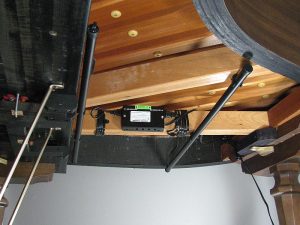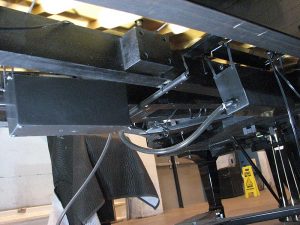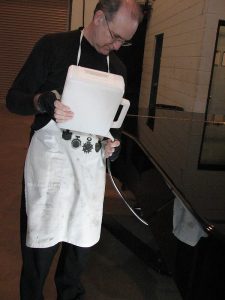Pianos and Humidity
A piano is made from natural materials – wood, felt, leather, and wool. All of these materials absorb moisture from the air. When the air gets more humid, the materials absorb more moisture. Then they give it up again when the air gets dryer.

As the relative humidity of the air increases, the soundboard’s moisture content increases along with it — this swells the wood. The soundboard’s crown increases with the swelling and intensifies the pressure against the strings. This raises the pitch of the piano. The opposite happens when the relative humidity decreases.
High humidity also causes the wooden parts of the piano’s action to swell. This can lead to sticking keys and a sluggish, unresponsive action. As the felts on the hammers swell from the humidity, the sound of the piano can become soft and muffled.
Humidity Can Damage a Piano
The repeated changes in the dimensions of the wood as the relative humidity rises and falls can eventually damage the piano. The sound board can crack and glue joints can separate. As the pin block repeatedly swells and contracts, the tuning pins that hold the strings can eventually loosen and the piano will no longer hold tune.
Humidity Control

Air conditioning reduces the humidity during the summer months, but this is often not quite enough. A stand-alone dehumidifier can reduce the humidity even more, but even this is usually insufficient because the optimum relative humidity for a piano is around 42% — quite a low value for the Gulf Coast in summer!
For more precise regulation of the humidity in the vicinity of the piano’s sensitive sound board, we need to control the humidity inside the piano itself.
Dampp-Chaser Humidity Control System
There is a humidity control system specially made for and widely used in pianos called the Dampp-Chaser Piano Life Saver. This system installs inside an upright or under a grand piano and stabilizes the relative humidity inside the instrument.

- A humidifier which raises the relative humidity (not often needed in Florida).
- A dehumidifying heater which lowers the relative humidity.
Usually, only the dehumidifying heater is needed in our climate. The heater is composed of one or more low-power heating elements which are controlled by an electronic humidistat. These mount near the piano’s sound board to control the relative humidity. The system prevents the piano’s moisture content from varying outside a preset range.
The reduced swings in humidity within the piano make its sound more stable, and can increase the piano’s life.
Authorized Dampp-Chaser Installer
I’m listed as a “Most Experienced Installer” by the Dampp-Chaser company.
To find my name on the Dampp-Chaser installers list, select “USA” and “FL”, then scroll down to “Panama City”. The gold asterisk by my name designates me as a Most Experienced Installer.
For more information see the Humidity Control Technical Bulletin at the Piano Technician’s Guild website.